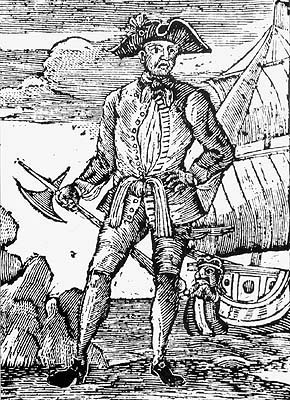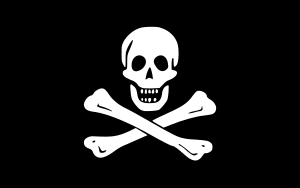Edward England facts for kids
Quick facts for kids
Edward England
|
|
|---|---|

An 18th century woodcut of England
|
|
| Born | c. 1685 |
| Died | 1720/21 (aged approximately 36) St. Augustine's Bay, Merina Kingdom
|
| Piratical career | |
| Nickname | Ned |
| Type | Pirate Former privateer |
| Allegiance | Kingdom of Great Britain (War of the Spanish Succession) |
| Rank | Captain |
| Base of operations | Southern Africa |
| Commands | Several vessels, most famously the Royal James and the Fancy. |
| Battles/wars | Battle with the Cassandra that caused his crew to mutiny and maroon him for sparing some captives. |
| Wealth | R 10,000,000 |
Edward England (c. 1685–1721) was an Irish pirate. The ships he sailed on included the Pearl (which he renamed The Royal James) and later the Fancy, for which England exchanged the Pearl in 1720. His flag was the classic Jolly Roger — almost exactly as the one "Black Sam" Bellamy used — with a human skull above two crossed bones on a black background. Like Bellamy, England was known for his kindness and compassion as a leader, unlike many other pirates of the time.
England was born Edward Seegar in Ireland around 1685. He took part in Henry Jennings' expedition for the sunken 1715 Treasure Fleet off the coast of Florida, and then began sailing with Charles Vane in 1718. Upon Vane and other prominent pirates accepting the King's Pardon, England and some of his men sailed for Africa. Along his way he spawned the career of Bartholomew Roberts, among others. In 1720, near the African island of Comoros, England and his men got into a violent conflict with James Macrae. After 10 days of hiding on an island, England and Macrae agreed to a peace deal, upsetting England's crew; he was subsequently voted out as captain and marooned on the island of Mauritius. After four months, England and the loyal crewman that had been stranded with him managed to build a boat and sail to a pirate safe haven in Madagascar. He died sometime in the winter of 1720–21, possibly from tropical disease.
Early life
Born in Ireland as Edward Seegar sometime around 1685, he was probably raised a Catholic, and was said to be an educated man. Seegar changed his surname to England when he turned pirate. Some sources claim "Seegar" was not England's name at all, but was instead a separate pirate (Jasper Seagar) who sailed under England. England made his way to Jamaica and during the War of the Spanish Succession he served as a privateer. He was captured by the pirate captain Christopher Winter and forced to join the crew. Winter took England to the pirate base on Nassau, Bahamas. England took part in Henry Jennings' assault on the Spanish salvage camp at Palma de Ayz, Florida, stealing £87,000 in gold and silver. England is next reported as Charles Vane's quartermaster, in March 1718. Vane's sloop, the Lark was captured by the Royal Navy, but England and the rest of the crew were released to induce the other pirates of Nassau to accept the King's pardon.
Captaincy – Coast of Africa
England was granted captaincy of his own ship in mid-1718. England decided not to accept the pardon along with Vane and a few others, and after the arrival of Woodes Rogers, they set sail for the coast of Africa.
Along the way, he and the crew took several ships. One of the ships was the Cadogan from Bristol, captained by a man named Skinner. Some of England's crew knew Skinner and recognized him instantly because he never paid them for their work previously.
A group of pirates next grabbed the captain, tied him to the windlass and threw empty bottles at him. Next because he had been a good master to his men they gave him a quick death by simply shooting him in the head with a flintlock pistol. Given the crew of the Cadogan was without a captain, England offered them a choice to join his crew. Aboard the crew was Howell Davis who refused to sign the articles of the pirates. Howell said he would rather die than become a pirate, however, England refused to kill him and instead gave command of the captured ship to Davis. This began the start of Davis' pirate career. Davis would go on to spawn the career of Bartholomew Roberts as well, and the careers of many other pirates.
After some time, England and his crew captured a larger brig or frigate named the Pearl. Taking the ship as their own, they renamed it the Royal James (after James Stuart, alluding to the Jacobitism of England or his crew) and in the spring of 1719 went off in search of plunder in Africa. Between the Gambia River and the Cape Coast, the pirates seized and looted ten ships. Two of these they kept as prizes, granting them to Captains Robert Lane and Richard Sample, who left England to sail for the Caribbean. After looting the ten ships, England made John Taylor the captain of his next prize, the Victory. After looting two additional ships, England and the crew decided to make port in a small African town. However, the pirates grew increasingly belligerent and conflicts arose with the locals over the treatment of women. Soon a fight broke out, resulting in the pirates burning the entire town and departing.
Indian Ocean
By 1720, England had reached the Indian Ocean, where he met with fellow pirate Captain Oliver la Buse. England captured a thirty-four gun Dutch ship, which he named Fancy in honour of English pirate Henry Every, and he made the Fancy his new flagship. England decided to attack an East Indiaman under the command of James Macrae, the Cassandra, near the island of Comoros. A long and bloody battle ensued, and both ships ran aground. Macrae and his surviving crew escaped and hid on the island for ten days. Finally Macrae, who was injured, tired, and hungry, went aboard England's consort the Victory, hoping for mercy, and surrendered to the pirates. The cargo of the Cassandra was valued at £75,000. Ninety of the Fancy's crew died in the attack on the Cassandra. England had a good nature and unusual kindness, in that he did not believe in torturing captives unless they could not otherwise be persuaded. England ordered Macrae's life spared, and the pirates kept the Cassandra and gave the heavily damaged Fancy to Macrae. ..... This enraged the pirates, particularly Taylor, who had wanted to kill Macrae. Around this time, Taylor organised a vote to remove England from command. The new captain – a former member of the Fancy crew named Jasper Seator – marooned England and three others on the coast of Mauritius, before taking Cassandra and Victory north in the hunt for more prizes. Seator died in 1721, with Cassandra eventually passing to Taylor who took her to the Caribbean.
Marooning in Mauritius
England and his three companions were put ashore without adequate provisions, and were forced to scavenge. After about four months, the men built a small boat and managed to sail to the pirate haven of St. Augustine's Bay in Madagascar.
Legacy
After arriving at St. Augustine's Bay, England survived for a while on the charity of other pirates, possibly some of Henry Every's old crew. He died in late 1720 or early 1721, possibly from a tropical disease.
England's son John eventually did as his father had wished and named his son John as well. This tradition continued among England's descendants.
Edward England is known today as one of the more humane pirate captains of the Golden Age of Piracy.




